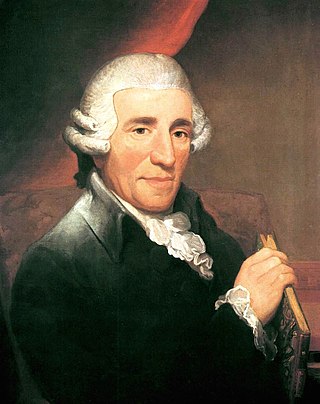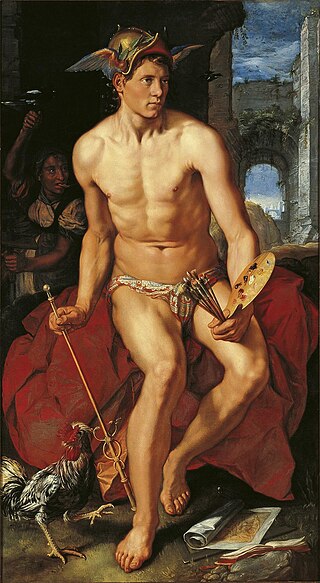Related Research Articles

Symphony No. 44 in E minor, Hoboken I/44, was completed in 1772 by Joseph Haydn. It is popularly known as Trauer. An apocryphal story relates that Haydn asked for the slow movement of this symphony to be played at his funeral.
Symphony No. 103 in E♭ major is the eleventh of the twelve London symphonies written by Joseph Haydn. This symphony is nicknamed The Drumroll after the long roll on the timpani with which it begins. It is from 1795, and his second-to-last symphony.
The Symphony No. 98 in B♭ major, Hoboken I/98, is the sixth of the twelve London symphonies composed by Joseph Haydn. It was completed in 1792 as part of the set of symphonies composed on his first trip to London. It was first performed at the Hanover Square Rooms in London on 2 March 1792.
Symphony No. 88 in G major was written by Joseph Haydn, for the orchestra of Esterháza under the benevolent Prince Nikolaus Esterhazy. It is notably the first of his symphonies written after the completion of the six Paris symphonies in 1786.

The Symphony No. 70 in D major, Hoboken 1/70, was written by Joseph Haydn to mark the start of construction of a new opera house on the Eszterháza estate. It was premiered on December 18, 1779—one of the few Haydn symphonies where the exact premiere date is known.

The Symphony No. 59 in A major is a relatively early work by Joseph Haydn that is known popularly as the Fire Symphony. Composed under the auspices of Nikolaus Esterházy, it was written in the middle or late 1760s.

The Symphony No. 52 in C minor is one of the last Sturm und Drang symphonies composed by the Austrian composer Joseph Haydn while the composer was in residence at Esterházy in 1771 or 1772.
Symphony No. 58 in F major, Hoboken I/58, is a symphony by Joseph Haydn, composed probably around 1767 but certainly not after 1774, after which time the traits of this symphony were outmoded. It is scored for two oboes, two horns and strings.
Maria Anna Sabina (von) Genzinger, called Marianne, was a Viennese amateur musician, the mother of six children, and a friend of the composer Joseph Haydn. Her correspondence with Haydn preserves a personal view of the composer not available from any other biographical source. Her daughter Josepa was a singer who gave the first performance of Haydn's Ariadne auf Naxos.

Symphony No. 43 in E♭ major, Hoboken I/43, is a symphony by Joseph Haydn. Since the nineteenth century it has been referred to by the subtitle "Mercury". The source of the "Mercury" nickname remains unknown according to Matthew Rye. It could refer to its use as incidental music from some play or other given at Eszterháza, or it may not have appeared until the nineteenth century. It would certainly be wrong to impose any programmatic elements on to the abstract musical drama and search for a portrait of the gods’ winged messenger.
Gary Cooper is an English conductor and classical keyboardist who specialises in the harpsichord and fortepiano. He is known as an interpreter of the keyboard music of Bach and Mozart, and as a conductor of historically informed performances of music from the Renaissance, Baroque, Classical and Romantic periods.
The Piano Sonata in B-flat major, Hob. XVI/18, L. 20, was written in 1767 by Joseph Haydn.
The Piano Sonata in D major, Hob. XVI/33, L. 34, was written in possibly 1777 by Joseph Haydn.
The Divertimento in G major, Hob. XVI/8, L. 1, was written in 1766 by Joseph Haydn.
Twenty Variations in G major, Hob. XVII/2, was written in the 1760s by Joseph Haydn. In 1788/1789, Artaria published the Arietta con 12 Variazioni in A major, which is an abridged version of the Twenty Variations in G major, and in a different key.
The Piano Sonata in D major, Hob. XIV/5, L.28, also called a divertimento, is a sonata written c.1765–1771 by Joseph Haydn. However, Anthony van Hoboken's catalogue states the composition date as "before 1766". It may have been written for 2 violins and cello.
Richard Lester is an English harpsichordist, organist, fortepianist and musicologist.
The Piano Sonata in E-flat major, Hob. XVI/49, L.59, was written in 1789/90 by Joseph Haydn. It marked the beginning of Haydn's late, mature style with frequent use of alternation between staccato (mostly) and legato (often/sometimes). The transitions were much smoother compared to his early and middle works, with larger first and second movements, and a smaller third movement.

The Sonata in C minor is a keyboard sonata composed by Joseph Haydn in 1771. It is also referred to as a piano sonata. The three-movement work was published by Artaria in 1780 in a set of six sonatas dedicated to the sisters Katharina and Marianna Auenbrugger.
References
- Anderson, Keith. Liner notes to HAYDN: Piano Sonatas Nos. 59-62. Jenoe Jandó. Naxos 8.550657. CD. 1993.
- Grout, Donald J. "Piano Trios." In Haydn studies, edited by Jens Peter Larsen, Howard Serwer, and James Webster, 274. NY: Norton, 1981.
- Landon, H. C. Robbins, and David Wyn Jones. "Haydn’s music 1781-1790." In Haydn: his life and music, 206. Bloomington: Indiana University Press, 1988.
- Landon, H. C. Robbins. "Piano Sonatas." In Haydn: Chronicle and Works 2, Haydn at Eszterháza, 1766-1790, 584. London: Thames and Hudson, 1978.
- Maxwell, Carolyn. “Sonatas." In Haydn, Solo Piano Literature: A Comprehensive Guide, Annotated and Evaluated with Thematics, edited by Carolyn Maxwell, Charles Shadle and Christine Armstrong, 56. Boulder, Colorado: Maxwell Music Evaluation, 1983.
- Schwartz, Judith L. Liner notes to Joseph Haydn: Piano Music, Volume I. Gilbert Kalish. Nonesuch Records 519787. CD. 1975.
- Sudbin, Yevgeny. "Haydn Liner Notes." Yevgeny Sudbin. Last modified February 10, 2010. http://www.yevgenysudbin.com/artist.php?view=essays&rid=621.
- Wigmore, Richard. Liner notes to Haydn Piano Sonatas II. Marc-André Hamelin. Hyperion CDA67710. CD. 2009.